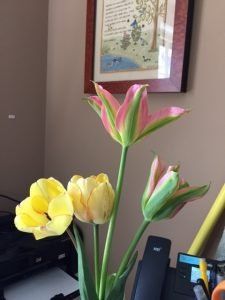(My) Tulip Thief
That was a long winter. Typically, I don’t complain but it was not nice weather-wise. And the cold and the wind – couldn’t Mother Nature have given us some more snow to at least enjoy – and break out that new sled we got my son – a “big boy sled.”
In any case, I have been watching the tulips I planted last fall in front of the Mitchell House. They started to break ground, then it got cold, then they came up a little more, then the bunnies got to them. (We now have THREE bunnies at Mitchell House. Imagine how many babies we will have! ARGH!)
I’ve been watching and watching these tulips as their leaves twisted, were eaten, snapped at by cold, flurries, and frost. And then, they started to grow more, and to show buds, and color! Is spring REALLY here?
And then the other night, a thief came! I had not even gotten down to Mitchell House yet when our Executive Director stopped me and said he had a, “What would Jascin do moment.” Not sure if I should be honored. But, needless to say from out of his window after dinner he spied a young man on his bicycle, bending over the Mitchell House fence, snipping away at the tulips! He raced downstairs in his pajamas and politely confronted the thief. The thief was embarrassed, taken aback, and was told to, “Drop the tulips!” – well, not exactly. He was told to leave them and then politely told that the MMA pays for those tulips and the work that goes into gardening. The thief left sheepishly.
The next day, I was in the Mitchell House with the front door open doing my annual mildew cleaning of the front sitting room ceiling when I heard someone at the door trying to open the locked screen. I got off my scaffold and found a young man at the door who I did not completely recognize at first. Then he said my name and I knew who it was. With him, he had a bag with three pots of tulips. “You’re my thief!?” I exclaimed. He replied, “They were just so pretty that I couldn’t resist. I just wanted them.” This thief is a former student of mine – way back from when in addition to the MMA, I also was a teacher. He is one of those students who could be trying at times, always pushing the edge, always finding something to get himself into trouble, but one that you will forever have a soft spot for. I hugged him. Yelled at him. Told him he only had to ask first, and then told him the names of his stolen items – Viricic and Beauty of Spring tulips from the Colorblends Company. And then gave him heck because I told him about the bunnies. I cannot be mad at him – he has a soft spot for gardens and flowers so I will take my choice of tulips – and my Mother’s – as a compliment.
(I’m thinking if further time is needed, he can come help me weed this summer.)
JNLF
Recent Posts





